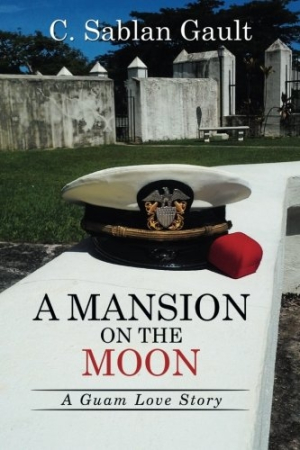A Mansion on the Moon
A Guam Love Story
Despite its tragic opening, the novel soars to dramatic heights as it illustrates that love can indeed conquer all.
C. Sablan Gault weaves an emotional tale about the enduring human spirit in her multigenerational saga, A Mansion on the Moon. Set on the Pacific island of Guam, the story begins with a thwarted love affair between a local girl and an American soldier, and follows that doomed union’s female descendants as they experience their own triumphs and losses. Despite the trials brought on by a war-torn backdrop, a simple truth prevails: love can provide a lifeline for survival.
The story opens in the wake of the Spanish-American War, when Guam became a territory of the United States. The transition brings two cultures into close contact, leading to liaisons between naïve local girls and hot-blooded American soldiers. Although people warn against these relationships—comparing the chances of a local girl winning the love of a soldier to catching the moon—some couples cannot help themselves. Such is the story of beautiful Amanda de Leon, who sacrifices an advantageous marriage for a passionate love affair that ultimately ends in tragedy. Amanda’s choice echoes through the lives of the women in her family until it reaches her granddaughter, Vivian—who, in spite of her grandmother’s unfortunate fate, makes the same decision.
While multiple love stories form the framework of A Mansion on the Moon, the true highlight of the novel is its astonishing detail about life on Guam. Spanning the turn of the twentieth century until the end of World War II, the novel chronicles many less-known aspects of native life and the country’s cultural transformation over the decades. While not passing judgment upon the United States, the narrative nevertheless refuses to flinch from acknowledging its colonial rule over the small island, and the ways that the U.S. both aided and injured Guam.
Just as gripping are the depictions of Japan’s terrifying occupation of Guam at the start of World War II. The book does not shy away from the devastation the war brought to the island. While many accounts of the Second World War focus on European battles, this change in setting offers an insightful glimpse into the Pacific-set conflict.
Though the prose is workmanlike, the emotional power of the intricate tale carries the story. Amanda’s doomed love affair provides the perfect contrast to Vivian’s faithful dedication to her soldier. Both women are products of their time, but so too are the soldiers who receive their devotion. While Amanda’s beau failed to rise above his circumstances, Vivian’s beloved chooses to fight the odds. Like its handling of America’s colonial rule over Guam, A Mansion on the Moon does not gloss over racial bigotry and prejudices, adding a realistic layer to this hopeful tale.
The star-crossed lovers of Gault’s novel humanize what is otherwise a story about a country in transition. The multigenerational aspects demonstrate how family histories are passed from parent to child, sometimes offering a cautionary tale and other times serving as a map. Despite its tragic opening, the novel soars to dramatic heights as it illustrates that love can indeed conquer all, if people are willing to work for it.
Reviewed by
Vernieda Vergara
Disclosure: This article is not an endorsement, but a review. The publisher of this book provided free copies of the book and paid a small fee to have their book reviewed by a professional reviewer. Foreword Reviews and Clarion Reviews make no guarantee that the publisher will receive a positive review. Foreword Magazine, Inc. is disclosing this in accordance with the Federal Trade Commission’s 16 CFR, Part 255.

